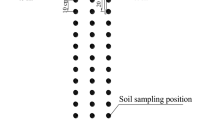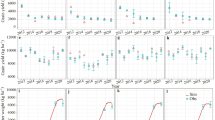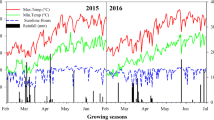Abstract
Optimal use of water and fertilizers can enhance winter wheat yield and increase the efficiencies of water and fertilizer usage in dryland agricultural systems. In order to optimize water and nitrogen (N) management for winter wheat, we conducted field experiments from 2006 to 2008 at the Changwu Agro-ecological Experimental Station of the Chinese Academy of Sciences on the Loess Plateau, China. Regression models of wheat yield and evapotranspiration (ET) were established in this study to evaluate the water and fertilizer coupling effects and to determine the optimal coupling domain. The results showed that there was a positive effect of water and N fertilizer on crop yield, and optimal irrigation and N inputs can significantly increase the yield of winter wheat. In the drought year (2006–2007), the maximum yield (Y max) of winter wheat was 9.211 t/hm2 for the treatment with 324 mm irrigation and 310 kg/hm2 N input, and the highest water use efficiency (WUE) of 16.335 kg/(hm2·mm) was achieved with 198 mm irrigation and 274 kg/hm2 N input. While in the normal year (2007–2008), the maximum winter wheat yield of 10.715 t/hm2 was achieved by applying 318 mm irrigation and 291 kg/hm2 N, and the highest WUE was 18.69 kg/(hm2·mm) with 107 mm irrigation and 256 kg/hm2 N input. Crop yield and ET response to irrigation and N inputs followed a quadratic and a line function, respectively. The optimal coupling domain was determined using the elasticity index (EI) and its expression in the water-N dimensions, and was represented by an ellipse, such that the global maximum WUE (WUE max) and Y max values corresponded to the left and right end points of the long axis, respectively. Considering the aim to get the greatest profit in practice, the optimal coupling domain was represented by the lower half of the ellipse, with the Y max and WUE max on the two end points of the long axis. Overall, we found that the total amount of irrigation for winter wheat should not exceed 324 mm. In addition, our optimal coupling domain visually reflects the optimal range of water and N inputs for the maximum winter wheat yield on the Loess Plateau, and it may also provide a useful reference for identifying appropriate water and N inputs in agricultural applications.
Similar content being viewed by others
References
Arnon I. 1975. Physiological principles of dryland crop production. In: Gupta U S. Physiological Aspects of Dry Land Farming. New Delhi: Oxford and IBH Publishing Co., 3–145.
Balasubramanian V, Chari A. 1983. Effect of irrigation scheduling on grain yield and nitrogen use efficiency of irrigated wheat at Kadawa and Bakura, northern Nigeria. Fertilizer Research, 4(3): 201–210.
Cai D T, Wang Y B, Mao Z S, et al. 1994. The effect of sowing date and nitrogen application under different ecosystem on the yield and qualit of the superior wheat variety. Plant Nutrition and Fertilizer Science, 1(1): 74–83.
Chen Z M. 1996. Nitrogen-Yield-Environment. Beijing: China Agriculture and Technology Press, 1–31.
Gajri P R, Prihar S S, Arora V K. 1993. Interdependence of nitrogen and irrigation effects on growth and input-use efficiencies in wheat. Field Crops Research, 31(1–2): 71–86.
Gao Y J, Li S X. 2003. Analysis of the effect of water and nitrogen fertilizer in farmland of Loess Plateau. Plant Nutrition and Fertilizer Science, 9(1): 14–18.
Gu S X, He D M, Cui Y L, et al. 2012. Temporal and spatial changes of agricultural water requirements in the Lancang River Basin. Journal of Geographical Sciences, 22(3): 441–450.
Guo S L, Zhou Y D, Zhang W J, et al. 2003. Effects of long-term application of chemical fertilizer on food production and soil quality attributes. Research of Soil and Water Conservation, 10(1): 6–22.
Hou L K, Zhang Y J, Zhan J Y, et al. 2012. Marginal revenue of land and total factor productivity in Chinese agriculture: Evidence from spatial analysis. Journal of Geographical Sciences, 22(1): 167–178.
Huang M B, Dang T H, Li Y S. 2002. Effect of advanced productivity in dryland farming of the Loess Plateau on soil water cycle. Transactions of the Chinese Society of Agricultural Engineering, 18(6): 50–54.
Huang Z L, Yao D N, Ma C X, et al. 1999. Effects of nitrogen application on yield and quality traits of different wheat varieties. Journal of Anhui Agricultural University, 26(4): 414–418.
Kong D, Yan Y, Duan Y, et al. 2008. Field experiment on growth and yields of winter wheat under different water and nitrogen treatments. Transactions of the Chinese Society of Agricultural Engineering, 24(12): 36–40.
Li F Y, Song L, Guan C Y, et al. 2000. Coupling effect of water and fertilizers on spring wheat yield in semi-arid area of western Liaoning Province. Chinese Journal of Applied Ecology, 11(4): 535–539.
Li J, Shao M A, Zhang X C. 2004. Simulation of water potential productivity of winter wheat and soil water dynamics on rainfed highland of the Loess Plateau. Journal of Natural Resources, 19(6): 738–746.
Li Y B, Zhen L M, Liao S H, et al. 2005. Effects of different patterns of irrigation and N application on grain yield and utilization ratio of water and nutrient of winter wheat in Beijing suburb. Journal of Triticeae Crops, 25(2): 51–56.
Liu W Z. 1997. An essential requirement of marginal analysis method for calculating farmland water inputs with the maximum profits in water-saving irrigation. Journal of China Agricultural University, 2(Supl.): 121–125.
Liu W Z. 1998. Dynamic interrelations of crop production, water consumption and water use efficiency. Journal of Natural Resources, 13(1): 23–27.
Liu W Z, Li Y S, Li S X. 2002. Graphical presentation and their characteristics of the coupled zones for optimal supplies of water and nutients to crops. Transactions of the Chinese Society of Agricultural Engineering, 18(6): 1–3.
Liu W Z, Zhang X C. 2007. Optimizing water and fertilizer inputs using an elasticity index: a case study with maize in the loess plateau of China. Field Crops Research, 100(2–3): 302–310.
Liu Z X, Zhen Z P, Wang J. 2000. Effect of interaction between water and fertilizer on wheat and maize semiarid region of western Liaoning. Chinese Journal of Applied Ecology, 11(4): 540–544.
Meng Z J, Jia D L, Wu H Q, et al. 1998. Mathematical model of water fertilizer interaction for water saving and high yield winter wheat in east area of Henan province. Transactions of the Chinese Society of Agricultural Engineering, 14(1): 86–90.
Miao G Y, Yin J, Gao Z Q, et al. 1997. Study on the combined effects of simulated rainfalls and nitrogen treatments on the yield and soil moisture dynamic change of rain-fed winter wheat. Acta Agronomica Sinica, 23(3): 263–270.
Sandhu K S, Arora V K, Chand R. 2002. Magnitude and economics of fertilizer nitrogen response of wheat in relation to amount and timing of water inputss. Experimental Agriculture, 38(1): 65–78.
Shangguan Z P, Liu W Z, Xu X B, et al. 1999. Interactive effects of water and fertilizer on yield of winter wheat in dryland. Research of Soil and Water Conservation, 6(1): 103–106.
Sharma B D, Kar S, Cheema S S. 1990. Yield, water use and nitrogen uptake for different water and N levels in winter wheat. Fertilizer Research, 22(2): 119–127.
Sharma B D, Jalota S K, Kar S, et al. 1992. Effect of nitrogen and water uptake on yield of wheat. Fertilizer Research, 31: 5–8.
Shen R K, Wang K, Zhang Y F, et al. 2001. Field test and study on yield, water use and N uptake under varied irrigation and fertilizer in crops. Transactions of the Chinese Society of Agricultural Engineering, 17(5): 35–38.
Tang K L. 1999. Characteristics and perspectives on scientific discipline of soil erosion and soil and water conservation in China. Research of Soil and Water Conservation, 6(2): 2–7.
Tang S H, Yang G H. 1994. Simulated study of the relationship among yield of winter wheat, water and fertilizer application in dryland. Agricultural Research in the Arid Areas, 12: 69–73.
Wang D S. 1995. Controlling Technique and Theories on Fertilizer & Water in Dry Farmland. Beijing: China Agricultural Scientech Press, 3–50.
Wu D T, Li H M, Jiao X Y, et al. 2001. Relationship between water and fertilizer for wheat and effect on wheat yield in rainfed field of Loess Plateau. Transactions of the Chinese Society of Agricultural Engineering, 17(5): 39–42.
Xie X Q. 2001. A study on water cycle in agro-ecosystem and relationship between crops and water. Chinese Journal of Eco-Agriculture, 9(1): 9–12.
Zhai B N, Li S X. 2003. Effect of water and nitrogen cooperation on winter wheat yield and quality. Plant Nutrition and Fertilizer Science, 9(1): 26–32.
Zhai B N, Li S X. 2005. Study on the key and sensitive stage of winter wheat respones to water dan nitrogen coordination. Scientia Agriculutura Sinica, 38(6): 1188–1195.
Zhang F X, Zhou M Y, Xu H P, et al. 2005. Effects of water and fertilizer coupling on growing and yield of winter wheat. Journal of Water Resources and Architectural Engineering, 3(2): 22–24.
Zhao X F, Wang L J, Li R Q, et al. 2009. Effect of irrigation times and nitrogen application rate on population dynamics and grain yield of winter wheat. Journal of Triticeae Crops, 29(6): 1004–1009.
Zhen R T, Liu Y F. 1995. Effects of water and fertilizer on crop yield and their quota drafted. Irrigation and Drainage, 14(2): 8–13.
Zhu Z L. 2000. Loss of fertilizer N from plants-soil system and the strategies and techniques for its reducion. Soil and Environmental Sciences, 9(1): 1–6.
Author information
Authors and Affiliations
Corresponding author
Rights and permissions
About this article
Cite this article
Fu, Q., Wang, Q., Shen, X. et al. Optimizing water and nitrogen inputs for winter wheat cropping system on the Loess Plateau, China. J. Arid Land 6, 230–242 (2014). https://doi.org/10.1007/s40333-013-0225-4
Received:
Revised:
Accepted:
Published:
Issue Date:
DOI: https://doi.org/10.1007/s40333-013-0225-4




